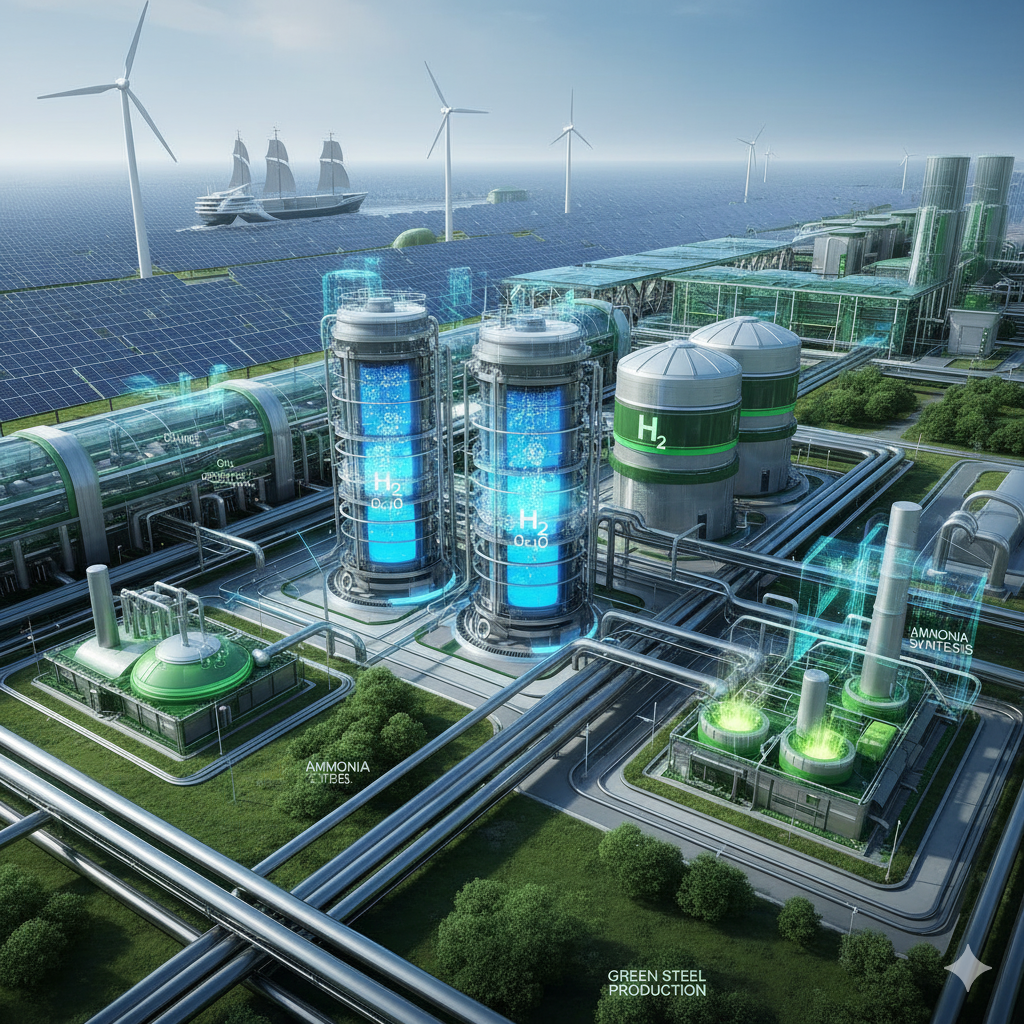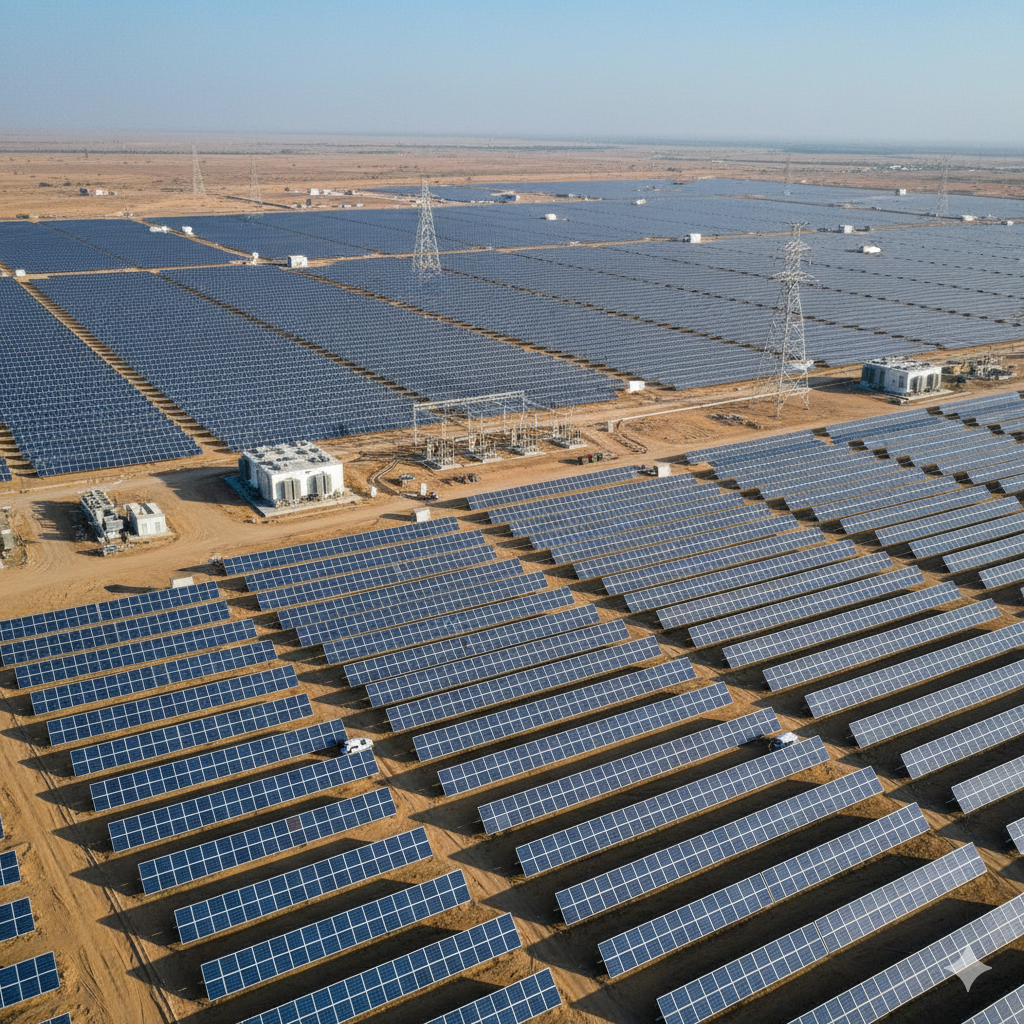
Key Highlights
- $400 billion required to achieve India’s 500 GW non-fossil fuel target by 2030, with strong FDI momentum attracting global investors
- 123-125 GW solar capacity installed as of August 2025, making India the world’s 3rd largest solar producer, up from just 4 GW in 2014
- 247.3 GW total renewable capacity by September 2025 with 52% from solar, 21% wind—achieving 50% non-fossil electricity generation five years ahead of schedule
- National Green Hydrogen Mission with ₹19,744 crore ($2.4 billion) outlay targeting 5 MMT annual production by 2030, expected to create 6 lakh jobs and attract ₹8 lakh crore investments
- 171 million people lifted from extreme poverty while energy transition creates massive investment opportunities across solar, wind, green hydrogen, and battery storage sectors
The Scale and Demand: India’s Unquenchable Energy Appetite
India’s energy story is one of rising ambition meeting massive untapped potential. As the world’s most populous nation, India faces a fundamental challenge: meet surging electricity demand sustainably.
Current Situation and Growth Trajectory
India’s total installed electricity capacity has crossed 450 GW, with renewable energy now representing 50% of non-fossil fuel capacity—a milestone achieved five years earlier than the 2030 target. This acceleration reflects not merely policy announcements but real, verifiable deployment on the ground. resiindia
By September 2025, India had installed 247.3 GW of renewable capacity (excluding large hydro), with solar dominating at 123 GW (nearly 52% of total renewables). In just the first nine months of 2025, India added a record 34.4 GW of solar and wind capacity—a 71% increase year-over-year. At this trajectory, India will likely exceed 300 GW by end-2025, putting it firmly on track for the 500 GW 2030 target.
Why the Urgency?
India’s electricity demand is projected to grow 3-4x faster than the global average. By 2032, India will need to meet 458 GW of peak demand, requiring not just capacity additions but intelligent grid infrastructure. The energy deficit—the gap between supply and demand—remains a structural bottleneck for industrial growth and rural electrification. ibef
The renewable energy opportunity is therefore not aspirational but existential for India’s development trajectory. Meeting this demand through coal alone would catastrophically exceed India’s carbon budget and derail the net-zero 2070 commitment. This is why global investors see India as the energy-transition growth story of the decade.
Policy Environment: The Foundation of Investor Confidence
Strong government policy is the invisible architecture enabling India’s renewable energy boom. For global investors accustomed to regulatory unpredictability in emerging markets, India’s policy consistency stands out.
100% FDI Under Automatic Route
India permits 100% Foreign Direct Investment in renewable energy projects under the automatic route—meaning no government approval required. This liberalized FDI regime has attracted $12.67 billion in renewable FDI by March 2025, with $11.8 billion flowing in just the first half of 2025 alone. For context, this surpasses India’s entire FDI in renewables during 2014-2020. mercomindia
The FDI inflow accelerated dramatically in Q1 2025—7.7x increase year-over-year to ₹84,309 crore ($9.8 billion)—reflecting investor confidence in India’s mid-decade trajectory.
National Green Hydrogen Mission: ₹19,744 Crore ($2.4 Billion)
Launched in January 2023, the National Green Hydrogen Mission positions India to become the global hub for hydrogen production and export. Key features:
- Strategic Interventions for Green Hydrogen Transition (SIGHT): Financial incentives for electrolyser manufacturing and green hydrogen production
- Target Production: 5 MMT (million metric tonnes) annually by 2030
- Expected Outcomes: ₹8 lakh crore investments, 6 lakh jobs, ₹1 lakh crore reduction in fossil fuel imports by 2030 gh2
- Market Potential: $8 billion market by 2030, scaling to $340 billion by 2050
Green hydrogen addresses India’s energy security obsession—reducing dependence on imported oil and natural gas while decarbonizing hard-to-abate sectors (fertilizers, steel, shipping, petrochemicals).
Production-Linked Incentive (PLI) Schemes
The PLI scheme for solar manufacturing—valued at ₹48,120 crore with ₹24,000 crore for solar PV modules and ₹24,000 crore for batteries—has catalyzed domestic manufacturing. By June 2025, PLI attracted ₹48,120 crore investments, generating 38,500 direct jobs. mnre.gov
Under SECI’s Tranche II of the PLI scheme, 11 manufacturers were awarded ₹13,937.5 crore to set up 39,600 MW of solar module manufacturing capacity. This represents a deliberate shift toward Atmanirbhar Bharat (self-reliant India) while reducing import dependence on Chinese modules.
Other Supportive Policies
- ISTS Transmission Charges Waived: Green hydrogen projects benefit till December 2030, offshore wind till December 2032
- Renewable Purchase Obligation (RPO): Binding obligation on distribution companies to source renewable power, creating guaranteed demand
- Accelerated Depreciation: Tax incentives for renewable projects
- Ease of Land Acquisition: Single-window clearance systems in some states for renewable projects
Landmark Projects and Regional Champions
India’s renewable energy landscape is not homogeneous—different states leverage comparative advantages. This regional focus attracts specialized investors and demonstrates sectoral diversity.
Rajasthan: India’s Solar Powerhouse
Bhadla Solar Park in Jodhpur, Rajasthan, stands as India’s largest solar installation and the 11th largest globally:
- 2,245 MW capacity spread across 14,000 acres (56 square kilometers)
- Approximately 10 million solar panels with high-efficiency tracking systems
- Annual generation: 7.32 million MWh—equivalent to powering 4.5 million households
- Developed in four phases with $1.4 billion in total investment
- Advanced technologies: Robotic cleaning (2,000+ Ecoppia robots), AI-based weather monitoring, smart grid controls
Bhadla exemplifies how harsh environmental conditions can become competitive advantages. The Thar Desert’s high solar irradiance (4.5-5.5 kWh/m²/day) and low population density enable massive capacity without land conflicts—a lesson lost on investors eyeing greener regions.
Gujarat: Khavda Hybrid Park—The World’s Largest
The Gujarat Hybrid Renewable Energy Park (Khavda) in Kutch is slated to be the world’s largest renewable energy park:
- Expected Capacity: 30 GW (25 GW solar + 5 GW wind hybrid)
- Land Area: 72,600 hectares (179,000 acres) of wasteland
- Investment: ₹150,000 crore ($18 billion)
- Timeline: 1 GW commissioned March 2024; full capacity by 2030
- Employment: 100,000 jobs
- CO2 Reduction: 5 crore tonnes annually
The park demonstrates India’s shift toward multi-gigawatt, integrated renewable complexes rather than scattered smaller projects. The presence of skilled grid operator Power Grid Corporation of India (PGCIL) and dedicated transmission infrastructure (with ₹18,598 crore allocation for evacuation) addresses the critical transmission bottleneck.
Ladakh: Green Energy Corridor and Battery Storage
Ladakh, India’s newest Union Territory, is positioned as a green energy frontier:
- Strategic location between India, China, and Central Asia makes it geopolitically significant
- High altitude and low population density ideal for solar and wind
- Government focus on battery storage to balance variable renewable generation
- Planned transmission corridors to feed power to energy-deficit Northern India
International Collaborations and Partnerships: The Global Confidence Signal
India’s renewable energy story is increasingly a co-authored narrative involving global institutional investors, multilateral development banks, and corporate conglomerates.
International Solar Alliance (ISA)
Founded jointly by India and France at COP21 (Paris Climate Conference 2015), the ISA now comprises 121 member countries and functions as a platform for technology transfer, financing, and capacity building.
In May 2025, India hosted the 8th ISA Assembly in New Delhi, where Minister Pralhad Joshi announced India’s achievement as the world’s 3rd largest solar producer with 125 GW capacity—establishing India as a Southern leadership model for renewable transition.
The ISA’s role extends beyond symbolic—the European Investment Bank (EIB) partnered with ISA to mobilize €800 million ($880 million) for renewable projects across ISA member countries, with emphasis on India.
India-EU Clean Energy Partnership
The India-EU Clean Energy and Climate Partnership (CECP), established in 2018, has evolved into a robust collaboration framework spanning:
- Joint manufacturing initiatives: EU equipment providers + Indian manufacturers creating resilient solar supply chains
- Green hydrogen cooperation: Technology transfer and pilot projects
- Energy storage: Development of battery storage ecosystems
- Skills development: Training programs for renewable sector workforce
In April 2025, SolarPower Europe and India’s National Solar Energy Federation (NSEFI) signed an MOU to strengthen EU-India cooperation on solar manufacturing, diversifying supply chains away from China dependence.
India-Australia Renewable Energy Partnership
Australia, blessed with abundant solar and wind resources, has become a knowledge partner for India on grid integration and variable renewable management.
Global Biofuel Alliance
India launched the Global Biofuel Alliance to promote sustainable biofuels as complement to electricity and hydrogen—diversifying the renewable energy portfolio.
Public-Private Partnerships: Corporate Giants Moving Into Renewables
The corporate landscape reveals a seismic shift in India’s energy incumbents:
Brookfield Asset Management operates nearly 40 GW of renewable assets across various stages in India and recently announced $1 billion investment in Avaada Group for green hydrogen and solar PV manufacturing.
ONGC-NTPC Joint Venture: In February 2025, ONGC NTPC Green (ONGPL) acquired Ayana Renewable Power for ₹19,500 crore ($2.3 billion)—the first major acquisition of a joint venture that was created to signal incumbent fossil fuel companies’ transition to clean energy.
ReNew Power, supported by British International Investment (>$100 million), has emerged as India’s largest pure-play renewables developer.
Japanese and German partnerships: Technology collaborations on advanced solar cells, wind turbines, and energy storage reflect global ecosystem participation.
Economic Impact, Investment Opportunities, and Financing Needs
The renewable energy sector has become an economic multiplier for India, creating employment, attracting capital, and building manufacturing ecosystems.
Investment Requirements and Capital Mobilization
Achieving the 500 GW target by 2030 requires $400 billion in total investment. Current FDI flow patterns suggest this is achievable: investindia.gov
- H1 2025 FDI: $11.8 billion (second-highest H1 inflow ever for Indian renewables)
- Q1 2025 FDI: 7.7x YoY increase to ₹84,309 crore ($9.8 billion)
- Annual Requirement: ₹900 billion-₹1 trillion ($10.7-11.9 billion) equity annually over 5-6 years
Blended finance mechanisms—combining concessional multilateral development bank funding with commercial capital—are becoming prevalent. IREDA, India’s renewable development financing agency, has issued over ₹10,907 crore in loans for rooftop solar alone.
Employment Creation and Skills Development
- National Green Hydrogen Mission: 6 lakh jobs by 2030
- Renewable sector cumulative: Over 1 million jobs already; exponential growth trajectory
- Manufacturing ecosystem: PLI scheme generating 38,500+ direct jobs in solar manufacturing
- Skill gaps: Growing mismatch between demand and supply of specialized technicians, engineers, grid operators
Emerging Market Segments
Solar PV Manufacturing: India achieved 100 GW solar module manufacturing capacity by August 2025, breaking China’s monopoly. With PLI extensions and policy support, capacity is projected to reach 80 GW by 2030.
Green Hydrogen: Still nascent but rapidly scaling. ReNew Power committed ₹26,400 crore and Acme Cleantech committed ₹27,000 crore for gigascale green hydrogen production capacity.
Battery Energy Storage Systems (BESS): Government tendered 4,000 MWh of battery storage capacity—a critical enabler for round-the-clock renewable power. However, domestic battery manufacturing remains immature, creating import dependence.
Rooftop Solar: Added 5.8 GW in nine months of 2025 (81% YoY growth), with PSU banks approving 5.79 lakh loan applications for rooftop installations. This represents the democratization of solar energy across households and SMEs.
Critical Analysis: Successes, Challenges, and Risks
India’s renewable energy story, while remarkable, faces formidable headwinds that could derail progress toward 2030 targets.
Successes: Why Investors Believe in India
- Rapid Capacity Deployment: India added 34.4 GW in nine months of 2025—the fastest pace globally. This surpassed the entire annual capacity additions of most years, demonstrating execution capability despite enormous complexity.
- Domestic Manufacturing Emergence: The rise of Indian solar manufacturers (Reliance, Waaree, JSW, TP Solar, Grew Energy) competing with Chinese incumbents is reversing decades of import dependence. India now produces 100 GW of solar modules annually.
- Grid Infrastructure Modernization: The Green Energy Corridor—dedicated transmission for renewables—has enabled 27.45 GW capacity commissioning, with another 36 GW in pipeline. Grid modernization and smart metering are advancing.
- Cost Competitiveness: Solar and wind are now the cheapest sources of electricity in India at ₹2.5-3/kWh—undercutting coal’s ₹3-3.5/kWh—creating organic demand.
Challenges: The Stubborn Bottlenecks
Transmission Bottlenecks and Grid Stability
- The most pressing challenge is grid integration of intermittent renewables. As of June 2025, over 50 GW of renewable capacity remains stranded due to incomplete transmission evacuation systems. In Rajasthan alone, 8 GW is stranded, with nearly 50% curtailed during peak solar hours.
- Grid events between January 2022 and May 2023 resulted in renewable generation losses of 1,000-7,000 MW per event, with Rajasthan’s renewable complexes experiencing 6-7 GW losses due to non-compliance with low/high voltage ride-through requirements.
- Solution Pathway: The ₹2.4 trillion transmission infrastructure plan aims to integrate 500 GW, but completion timelines of 3-6 years for transmission projects create deployment delays.
Land Acquisition: The Unspoken Crisis
Land remains the Achilles heel of India’s renewable expansion. Recent events highlight the severity:
- Andhra Pradesh (July 2025): Farmers blocked an 8,000-acre acquisition for solar manufacturing; highway blockades ensued
- Assam (June 2025): A 1 GW solar project was cancelled entirely after tribal communities vehemently opposed land acquisition; the Asian Development Bank withdrew a $434 million loan approval
- Karnataka: A 2 GW pumped storage project worth $918 million faces landowner opposition
Structural Issues:
- Land fragmentation and unclear titles slow acquisition
- Bureaucratic delays in permissions (6-12 months average, sometimes exceeding 2 years)
- Inadequate compensation driving litigation
- Displacement of marginalized communities losing social license to operate
The MNRE exempted solar/wind projects from mandatory social impact assessments—a regulatory shortcut that backfires when communities feel excluded.
Energy Storage: The Missing Link
Renewable intermittency necessitates storage. However, battery energy storage deployment lags aspirations:
- Local manufacturing gap: ACC PLI programme (Advanced Chemistry Cell) has disbursed zero incentives to date as manufacturers cannot meet domestic content requirements
- High financing costs: BESS projects face 400+ basis points additional capital costs due to perceived risks and contract uncertainties
- Supply chain vulnerabilities: Import duties on batteries remain high to encourage local manufacturing, but international supply chain uncertainties constrain projects
Current battery storage deployments fall far short of the 4,000 MWh capacity required for grid stability.
Transmission Losses and Rural Inclusion
- Average transmission loss: 19-22% of generated electricity dissipates during transmission—among the world’s highest
- Distribution challenge: Rural areas with diffuse demand patterns and low willingness-to-pay for electricity create financial viability problems for distribution companies
- Rural inclusion paradox: Renewable energy expansion benefits urban industrial consumers; rural households often lack grid connections despite political rhetoric
Risks: Tail Risks to Monitor
Commodity Price Volatility: Green hydrogen competitiveness hinges on renewable electricity costs staying below $30/MWh. Any spike in silicon, polysilicon, or rare earth prices for manufacturing could invalidate project economics.
Geopolitical Uncertainties:
- US-China trade tensions: Potential tariffs on Indian solar exports or restrictions on Chinese modules reaching India via India
- Supply chain diversification failure: If India cannot absorb ₹2.4 trillion in transmission investments amid fiscal constraints, project delays cascade
- Regional cooperation failure: Cross-border renewable energy trade frameworks (SAARC, ASEAN) remain nascent
Overdependence on Select Technologies: India’s 52% solar concentration creates weather-dependent generation patterns. Diversification into offshore wind, green hydrogen, and tidal remains aspirational.
Climate Variability: Rising temperatures reduce solar panel efficiency. Drought impacts hydropower. Monsoon variability affects wind patterns. Climate adaptation must accompany climate mitigation.
Policy Lessons and Decision-Making Framework
India’s renewable energy experience offers critical lessons for policymakers navigating energy transitions.
Lesson 1: Policy Certainty Over Subsidies
India’s success stems not from aggressive subsidies but from long-term policy certainty. The National Action Plan on Climate Change (2008), National Solar Mission (2010), and consistent renewable energy targets created predictable demand. Investors respond to predictability more than subsidy levels.
Contrast with Germany’s feed-in tariff experimentation creating feast-bust cycles or Brazil’s subsidy withdrawal causing sector collapse. India’s steady-state approach—RPO trajectory, ISTS charges waivers, PLI multi-year commitments—demonstrates that credible policy frameworks beat generous but volatile subsidies.
Lesson 2: Regional Heterogeneity Demands Localized Solutions
A one-size-fits-all renewable strategy fails. Gujarat, Rajasthan, Tamil Nadu, and Maharashtra each leveraged geographical advantages (wind resource zones, solar irradiance, wasteland availability) and state capacities differently. Successful transitions require subsidiarity—decentralized decision-making respecting state-level implementation capacity.
Lesson 3: Manufacturing as Strategic Imperative
India learned from past energy transitions (oil dependence, nuclear technology). The PLI scheme’s focus on domestic solar and battery manufacturing embeds economic sovereignty into energy sovereignty. Manufacturing jobs anchor political support for renewable transitions in ways that pure capacity additions do not.
Lesson 4: Public-Sector Institutions as Catalysts
NTPC’s pivot into renewables (ONGPL acquisition of Ayana), SECI’s role in aggregating procurement, IREDA’s concessional financing demonstrate that **incumbent energy institutions can be reimagined rather than entirely dismantled during transitions.
Lesson 5: Addressing Distributional Conflicts Upfront
The land acquisition crises reveal that renewable energy transitions create real losers—farmers losing productive land, tribal communities displaced, rural workers becoming redundant. Technical/financial interventions alone fail; inclusive policy design addressing compensation, rehabilitation, and alternative livelihoods becomes essential.
Integration with Sustainable Development Goals (SDG-7)
SDG-7 (Affordable, Reliable, Modern Energy Services) frames India’s transition as not merely environmental but developmental:
- Universal Energy Access: Electricity coverage reached 99.99% of villages by 2024
- Clean Cooking: PMUY LPG scheme distributed 400+ million deposit-free connections, reducing kerosene consumption by 77%
- Grid Reliability: Smart grid initiatives improve supply quality
- Affordability: Renewable energy’s cost competitiveness makes electricity more affordable long-term
- Modern Energy Services: Digital payment systems (UPI), smart meters, and AI-driven demand management
Forward Path: Way Ahead
Achieving the 500 GW target by 2030 and net-zero by 2070 demands course corrections and accelerations.
Accelerate Transmission Infrastructure
The ₹2.4 trillion National Electricity Transmission Plan must be fast-tracked to 2-3 years from the standard 3-6 years. This requires:
- Single-window clearance for transmission projects across environmental, forest, wildlife approvals
- Underground cabling where necessary (high environmental cost but shorter timelines)
- Conditional contracts holding power plants liable for transmission delays, creating accountability
Resolve Land Acquisition Through Multi-Stakeholder Engagement
- Community benefit agreements: Revenue-sharing models where local communities receive percentage of project revenues
- Land-lease vs. ownership: Encouraging voluntary leasing (25-30 years) rather than acquisition, respecting land tenure security
- Rehabilitation assistance: Genuine livelihood restoration for displaced communities
- Grievance redressal mechanisms: Third-party arbitration for compensation disputes
Catalyze Battery Manufacturing Ecosystem
- Remove import duties on lithium, cobalt, and battery components to lower costs
- Extend ACC PLI deadlines and relax domestic content requirements temporarily
- Public investments in battery manufacturing through NTPC and ONGC partnerships
- Regional battery hubs: Dedicate states for battery manufacturing similar to solar parks
Develop Sector-Specific Hydrogen Applications
Rather than generic green hydrogen, focus on hard-to-abate sectors:
- Steel: Direct hydrogen reduction replacing blast furnaces
- Shipping: Ammonia as shipping fuel
- Fertilizers: Green hydrogen for ammonia synthesis (80% of India’s hydrogen demand)
- Petrochemicals: Hydrogen for refinery processes
Strengthen Rural Renewable Ecosystem
- Mini-grids and decentralized solar: Millions of off-grid households and businesses can be served by local solar installations + battery storage
- Agricultural support: Solar for irrigation, agro-processing reduces farm input costs
- Skill development: Train rural youth as solar technicians, creating distributed workforce
Conduct Decadal Policy Reviews
- Renewable Purchase Obligation (RPO) should escalate beyond 2029 to 100% by 2040
- Carbon pricing: Introduce carbon tax or carbon market to make fossil fuels uncompetitive
- Transmission pricing reform: Eliminate cross-subsidies between industrial and rural users to improve affordability
Conclusion: A Strategic Moment for Global Investors and India

India stands at an inflection point where ambition is encountering execution reality. Global green energy giants are betting on India not out of philanthropy but because the returns are attractive, the policy framework credible, and the growth runway long.
The $400 billion requirement for 500 GW is a constraint but also an opportunity. International climate finance, blended finance mechanisms, and private equity inflows can unlock this capital if:
- Policy consistency is maintained through electoral cycles
- Land conflicts are resolved through inclusive processes
- Manufacturing ecosystem scales to reduce technology import dependence
- Grid integration challenges are treated as urgent priorities
India’s renewable energy transition encapsulates the macro-economic, geopolitical, and development challenges of the 21st century:
- How can a developing nation balance energy security with climate action?
- Can market forces and state capacity work synergistically?
- How do distributional conflicts get managed in energy transitions?
- What does energy justice mean in a country of 1.4 billion?
The answers being written in India’s solar parks, hydrogen plants, and renewable policy debates will reverberate across the Global South, offering lessons for climate action that doesn’t repeat the mistakes of the wealthy world’s energy transitions.









+ There are no comments
Add yours